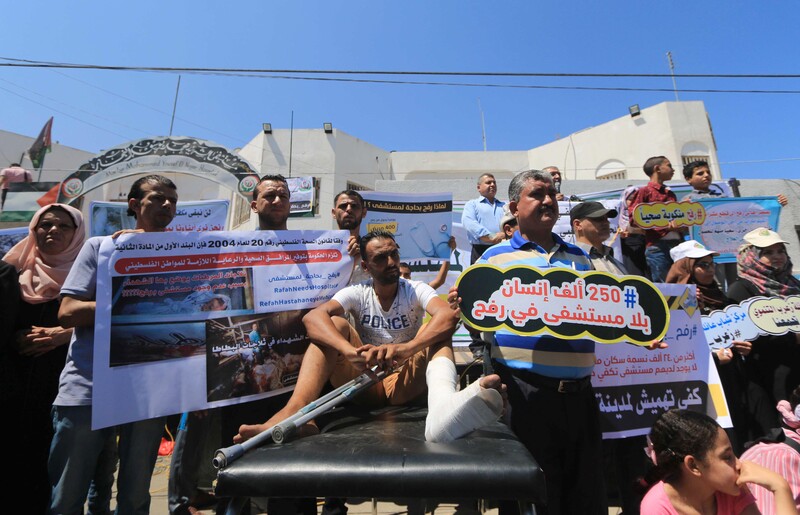The Electronic Intifada 25 November 2019

Protests have been held to press for improved medical care in Rafah, Gaza’s southernmost city.
ZUMA PressThe emergency department in Abu Yousef al-Najjar hospital only has nine beds, yet has to deal with hundreds of patients each day.
With such a limited capacity, the department is constantly overstretched. During periods of extreme violence, its staff work under hellish conditions.
Waheed Abu Ghali, a nurse in the department, recalls one particular man brought to the hospital at the time of the major Israeli offensive against Gaza in July and August 2014. “The man’s intestines were out of his abdomen,” said Abu Ghali, suggesting he was hit by an explosive weapon.
Despite those horrific injuries, the staff Abu Yousef al-Najjar had to turn the man away – referring him to another hospital – as they had even more urgent cases.
Located in Rafah – Gaza’s southernmost city – the hospital itself came under attack by Israeli troops on 1 August 2014.
“During the same period, the hospital’s morgue did not have enough space,” said Abu Ghali. “We had to put some of the bodies of people killed in ice cream and vegetable freezers provided by local traders.”
More recently, the hospital has treated many people injured during the Great March of Return. Those weekly protests, in which Palestinian refugees demand their right to return to lands from which they were expelled by Zionist forces, began in March 2018.
Frustrated
Abu Yousef al-Najjar is the only public sector general hospital serving Rafah, which has approximately 240,000 residents.
Frustrated by the inadequate health care available to them, people in Rafah are campaigning for a new modern hospital.
Hidaya Shamoun, a journalist, is one of the most vocal advocates for a new hospital. The campaign, she said, “has its roots in the 2014 Israeli attack on Rafah as Abu Yousef al-Najjar proved incapable of dealing with casualties then.”
While periods of extreme violence inevitably place extra strain on the hospital, Abu Yousef al-Najjar also struggles to deal with more mundane situations.
Suheib Ayyash, now aged 10, was injured in his leg last year while playing football. Ahmad, the boy’s father, promptly brought him to the hospital.
At the emergency department, Ahmad was told that his son required stitches but that the hospital was running low on dressings.
“I went to a pharmacy and bought dressings at my own expense,” Ahmad said. “How come the whole city of Rafah relies on one hospital that doesn’t even have basic things like dressings?”
The dialysis section at Abu Yousef al-Najjar has just two doctors who have to cater to more than 100 patients with kidney complaints. The hospital’s dialysis machines are in constant use from 6 am to 11 pm.
Only adults are treated in this section. Children with kidney complaints in Rafah are brought by ambulance to Gaza City – about 30 kilometers away – for dialysis twice per week. “Having to do this journey twice a week leaves the children exhausted,” said Rawad Badawi, a volunteer with a Rafah charity assisting people with kidney issues.
Promises not kept
The Palestinian Authority – headquartered in the occupied West Bank city of Ramallah – announced during 2015 that $24 million had been earmarked to provide Rafah with new medical facilities. The money would come from international aid pledged following the 2014 attack.
The $24 million has still not materialized. The health ministry in Ramallah did not respond to a request for comment.
Campaigners have identified a site in western Rafah where they wish to see a new hospital built. At a recent public meeting, local residents decided to draw up a blueprint for a hospital and submit it to the authorities.
“We are not going to stop campaigning for a new hospital until we see construction work actually taking place,” said the journalist Hidaya Shamoun. “Many people have made promises in the past. But all the promises have been verbal.”
Rami Almeghari is a journalist and university lecturer based in the Gaza Strip.





